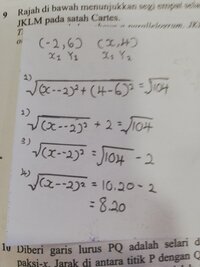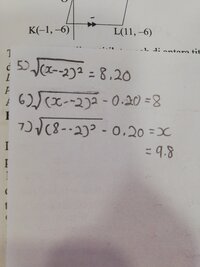Hi. The first line of your work is good, but in the second line we cannot simplify only part of the square root on the left-hand side. In other words, this type of separation is not allowed:
\(\displaystyle \color{red}\sqrt{(x \;– \;\text{-}2)^2} + \sqrt{4}\color{black}\)
Maybe you were thinking of the property
[imath]\quad\sqrt{a\times b}=\sqrt{a} \times \sqrt{b}[/imath]
but there is no similar property for addition.
Instead, we can remove the square root symbol on each side of line 1) by
squaring both sides of the equation. Your line 2) could look like this:
\(\displaystyle {\bigg( \sqrt{(x \;– \;\text{-}2)^2 + (4 \;–\; 6)^2} \bigg)}^2 = {\bigg(\sqrt{104} \bigg)}^2\)
Also, subtracting a negative number is the same thing as adding the opposite number, so line 3) could look like this:
\(\displaystyle (x + 2)^2 + (\text{-}2)^2= 104\)
Continue solving for x. Feel free to ask questions, if anything's unclear.

[imath]\;[/imath]


